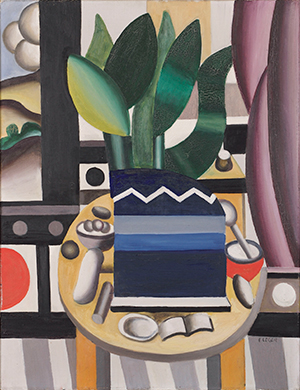
Still Life (Nature morte), 1922
Fernand Léger
Still Life (Nature morte), 1922
Oil on canvas
65 x 50 cm
Hermann und Margrit Rupf-Stiftung, Kunstmuseum Bern
© Fernand Léger, VEGAP, Bilbao, 2016.
“The Beautiful is everywhere […] perhaps [more so] in the arrangement of your saucepans on the white walls of your kitchen than in your eighteenth-century living room or in the official museums” Fernand Léger, 1924 [1]
Fernand Léger (Argentan, France, 1881–Gif-sur-Yvette, France, 1955) began to be drawn to the art world as an architect’s apprentice in the French city of Caen between 1897 and 1899. In 1890, he moved to Paris to work as a draftsman, an experience which was later reflected in the aesthetic of his paintings. After completing his military service (1902–1903), Léger entered the School of Decorative Arts and the Julian Academy, since he did not manage to secure a place for himself in the Fine Arts School [2]. Towards the end of 1907, the artist visited the Autumn Salon in Paris, where he was impacted by the work of Paul Cézanne (Aix-en-Provence, 1839–Aix-en-Provence, 1906), who exerted an influence over his subsequent paintings [3]. In around 1910, Léger exhibited his works in the gallery owned by Daniel-Henry Kahnweiler alongside the Cubist works of Pablo Picasso (Málaga, 1881–Mougins, France, 1973) and Georges Braque (Argenteuil-sur-Seine, 1882–Paris, 1963), from whom he also drew inspiration. This is where the collector Rupf probably saw Léger’s paintings for the first time [4].
With the outbreak of World War I in 1914, Léger was drafted to fight with the French army and participated in several battles, including Verdun [5]. Profoundly affected by his experiences on the front line, the artist made several sketches of soldiers, airplanes and artillery elements. Towards the end of the war, Léger spent some time hospitalized, and that is where he embarked on what is known as his “mechanical period,” which lasted until 1923, in which the figures and objects are characterized by their geometric shapes (circles, ellipses, curves, diagonals, rectangles, etc.) reminiscent of machine parts [6]. These forms were based on the sketches he had made during the war and are related to his experiences during this traumatic stage in his life.
The effects of the war also changed the way the artist thought; from then on, he focused on making art accessible to the working classes through simpler subjects and more realistic images [7]. His works began to distance themselves from pre-war abstract art and instead depicted “real objects,” going back to more classical subjects like still lifes and nudes [8]. During the 1920’s, he prioritized clarity, harmony, geometric composition, decoration and everyday life [9].
Still Life, from 1922, is part of a series of works of the same name which is comprised of pieces that show a succession of distorted cylinder-shaped objects which seem to be intertwined. After World War, Léger softened his pictorial universe: the colors he used—red, white and blue—evoke the cylinders of barber shops or circus drums. Léger drew from the aesthetic of the machine, and the other elements take on geometric shapes simplified to the extreme. These are just some of the features through which Léger’s works are similar to Futurism, along with his use of colors and his rhythmic arrangement of the canvas. The artist used bright, shiny tones far from the colors found in nature. Towards the end of his life, Léger recalled having been blown away by the magic of the sunlight glinting off the white metal of the shooting mechanism of a 75-mm canon. He said that this light taught him more in his development as an artist than all the museums in the world [10].
At the end of the war, the gallery owner Kahnweiler managed to return to France after having spent the war years in Bern (Switzerland) with his friend, the collector Rupf. Upon his return, he opened a new gallery in Paris, the Galerie Simon, which had four large light-filled exhibition rooms. This is the same gallery where years later Rupf purchased Fernand Léger’s Still Life (1922).
Preguntas
Look at the painting and describe it in as much detail as possible. What objects can you recognize? What elements seem ambiguous to you? What is the relationship among them?
Imagine that you can leap inside the painting. Where would you be? What would the climate be like there? What would you be doing? Where would you want to go? What sounds, scents and sensations would you perceive? Would you like being there? Why?
The title of the work is Still Life. A still life is a painting genre which was first seen in some works from the ancient world, although it became very popular in Western art after the 17th century. In still lifes, artists portray inanimate objects (fruit and flowers, game that has been hunted, food, receptacles and other objects). If you had to paint a still life today, what objects would you choose to paint? Look for a still life from the 17th century. In what way is it similar to Léger’s? What about to the one you would have painted?
Léger painted this work during what is known as his “mechanical period.” How would you describe this style? Write your own definition of “mechanical period.” Can you see the features of this period reflected in this work?
Look for works by Léger created before 1914, when World War I began, in books or on the Internet. Compare them with his works painted after the war. What differences can you see in his aesthetic? Are there any formal similarities? Do you think that the war only influenced his artistic style, or do you think that it may have also impacted his subject matter? If so, how? How did his painting change after the war?
